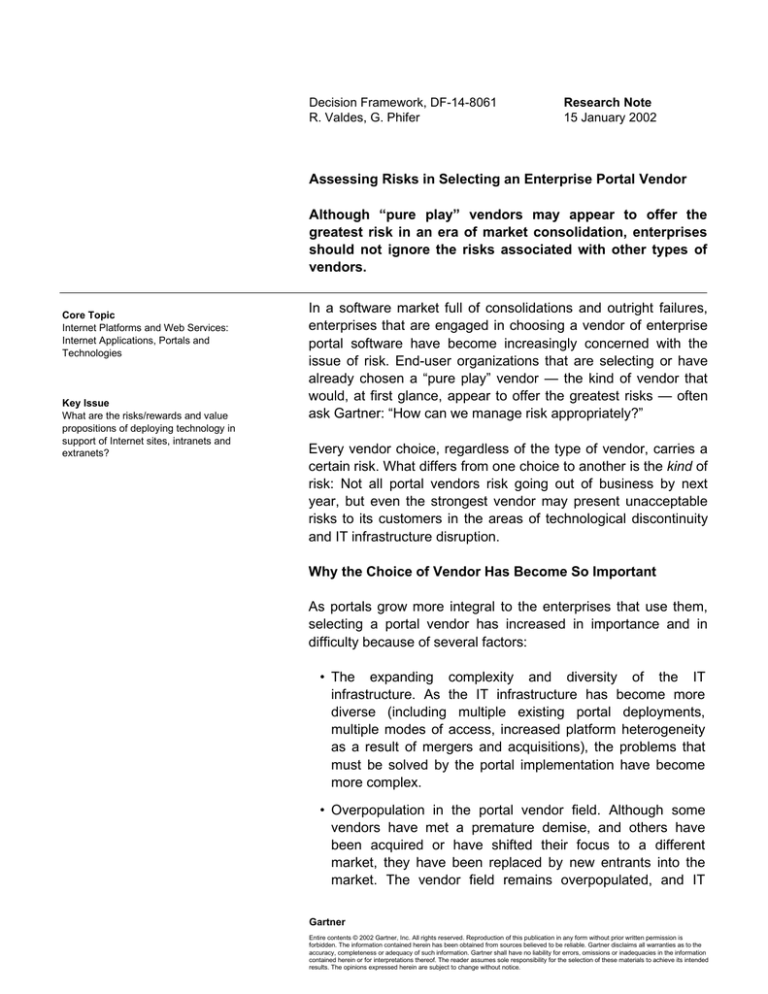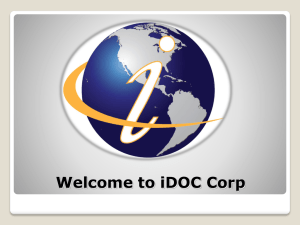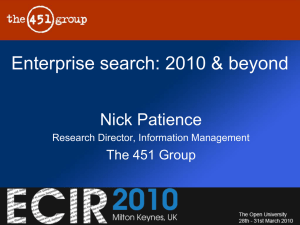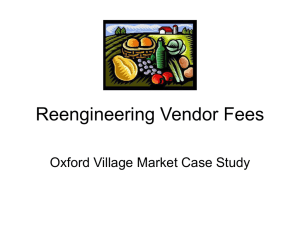
Decision Framework, DF-14-8061
R. Valdes, G. Phifer
Research Note
15 January 2002
Assessing Risks in Selecting an Enterprise Portal Vendor
Although “pure play” vendors may appear to offer the
greatest risk in an era of market consolidation, enterprises
should not ignore the risks associated with other types of
vendors.
Core Topic
Internet Platforms and Web Services:
Internet Applications, Portals and
Technologies
Key Issue
What are the risks/rewards and value
propositions of deploying technology in
support of Internet sites, intranets and
extranets?
In a software market full of consolidations and outright failures,
enterprises that are engaged in choosing a vendor of enterprise
portal software have become increasingly concerned with the
issue of risk. End-user organizations that are selecting or have
already chosen a “pure play” vendor — the kind of vendor that
would, at first glance, appear to offer the greatest risks — often
ask Gartner: “How can we manage risk appropriately?”
Every vendor choice, regardless of the type of vendor, carries a
certain risk. What differs from one choice to another is the kind of
risk: Not all portal vendors risk going out of business by next
year, but even the strongest vendor may present unacceptable
risks to its customers in the areas of technological discontinuity
and IT infrastructure disruption.
Why the Choice of Vendor Has Become So Important
As portals grow more integral to the enterprises that use them,
selecting a portal vendor has increased in importance and in
difficulty because of several factors:
• The expanding complexity and diversity of the IT
infrastructure. As the IT infrastructure has become more
diverse (including multiple existing portal deployments,
multiple modes of access, increased platform heterogeneity
as a result of mergers and acquisitions), the problems that
must be solved by the portal implementation have become
more complex.
• Overpopulation in the portal vendor field. Although some
vendors have met a premature demise, and others have
been acquired or have shifted their focus to a different
market, they have been replaced by new entrants into the
market. The vendor field remains overpopulated, and IT
Gartner
Entire contents © 2002 Gartner, Inc. All rights reserved. Reproduction of this publication in any form without prior written permission is
forbidden. The information contained herein has been obtained from sources believed to be reliable. Gartner disclaims all warranties as to the
accuracy, completeness or adequacy of such information. Gartner shall have no liability for errors, omissions or inadequacies in the information
contained herein or for interpretations thereof. The reader assumes sole responsibility for the selection of these materials to achieve its intended
results. The opinions expressed herein are subject to change without notice.
managers have accepted Gartner’s prediction that the
population will be culled significantly by market forces as this
segment matures.
• The high visibility and increasing importance of enterprise
portal projects. The political stakes have been raised within
the enterprise for those who champion a new portal
deployment. The outcome is not simply success vs. failure,
because larger enterprises frequently have multiple portal
initiatives developing in parallel. A modest success may not
enough to prevail against a competing project in another
business unit.
Portal Vendor Types and Their Associated Risks
Portal vendors can be classified according to size and product
line, in three categories: large, midsize and pure-play. The
conventional wisdom is that the pure-plays are the riskiest
category. This is true with regard to one kind of risk: vendor
viability. However, other types of risks should not be ignored.
Here, we outline the different categories of vendors and discuss
the various kinds of risks associated with vendors from each
category.
Large IT Vendors
Definition: These are vendors with multibillion-dollar annual
revenue, an established presence in multiple markets and
diverse product lines, which can include systems, software
infrastructure, applications and consulting services. Most have
been in existence for 10 years or more. In many cases, their
portal packages are fresh off the launching pad or acquisition
table.
Examples: This category can be further subdivided into system
vendors (IBM, Sun Microsystems/iPlanet), software platform
vendors (Microsoft) and large, independent software vendors
(ISVs; e.g., SAP, PeopleSoft, Oracle, Sybase, Computer
Associates).
Risks: Although most large vendors will likely remain standing
five years from now, because of the simple inertia of a sizeable
installed base, the life span of their portal products may be quite
short. The driving force behind product discontinuity and
technological disruption can come from inside or outside the
vendor’s organization. Internally, vendors continually reevaluate
and rearrange their product portfolio to replace anemic offerings
with different packages. The product name may remain the
same, but the underlying technologies and application
programming interfaces (APIs) may change. Externally, large
and small vendors are forced to respond to industrywide sea
Copyright 2002
DF-14-8061
15 January 2002
2
changes (such as the client/server, Internet, XML and Web
services initiatives). Rather than risk getting left behind, vendors
will regularly replace one foundation-level technology with
another.
As examples, consider Microsoft customers that have deployed
portals based on Site Server or Microsoft Exchange Digital
Dashboard. These users may not be feeling insulated from
discontinuity as SharePoint Portal Server enters the picture. The
same applies to users who relied on the Microsoft Web platform
— Active Server Pages (ASP) and VBScript — and now have to
migrate to ASP.NET and VB.NET. Future releases of the
SharePoint product will be migrated from ASP to the .NET
platform, with ramifications that are not yet known. IBM has
discontinued its Domino-centric portal product (K-station) and is
merging its features into WebSphere Portal Server (WPS). IBM
customers that adopted the Enterprise Information Portal (a
search engine positioned initially as a portal) will need to migrate
to WPS as well. Other examples abound with respect to large
vendors such as Oracle, SAP and Computer Associates.
Furthermore, all portal vendors — large and small — are chasing
the rapidly evolving set of industrywide Web services standards,
and their impact on vendors’ proprietary APIs has yet to be
unveiled.
Additional types of risks include budget risks and time-to-market
risks. These risks can be found among vendors of all sizes, but
more frequently occur with offerings from the largest vendors.
The budget risk is that portal customers will overspend on a
portal package and break the project’s budget. The time-tomarket risk results from implementation cycles tend to lengthen
in proportion to vendor size (although slipped schedules can
occur with understaffed small vendors as well).
Midsize, Diversified Vendors
Definition: These are vendors with established revenue streams
from products that predate portals, with revenue in the hundreds
of millions of dollars. Most have been in existence for five or
more years. In many cases, the portal products from this set of
vendors are very recent arrivals to the market.
Examples: Middleware vendors (BEA Systems, Iona
Technologies, Tibco), CRM/SFA (Siebel Systems), business
intelligence (Brio, Cognos), knowledge management/search
(Verity, Autonomy), application servers (SilverStream) and others
(Bowstreet, Citrix/Sequoia, Netegrity/DataChannel)
Risks: This sector will experience more company attrition than
the large-vendor sector, but not as much as the pure-plays.
Copyright 2002
DF-14-8061
15 January 2002
3
Although this sector poses less vendor risk than the pure-play
category, the product risk may be greater. Many of the portal
offerings from these vendors can be viewed as opportunistic
forays from related markets by vendors that may lack a long-term
commitment to the space, or in some cases, a full awareness of
requirements. For example, a middleware vendor that is expert in
server-to-server transactions may not have staff members with
experience in one of the core value propositions of an enterprise
portal: the improvements in user experience and usability that
come from a unified presentation model for widely used
enterprise applications. Portals are just as much about user
interface, collaboration, organizational structure and content
authoring as they are about machine-to-machine transfers of
data and enterprise application integration. The risk of
misunderstood requirements is, therefore, greatest in this
segment. The larger players are not immune from
misunderstanding a market, but they have the resources to make
a strategic commitment over the long haul, and can fine-tune the
product over multiple releases to better meet market
requirements.
Pure-Play Portal Vendors
Definition: These are focused vendors, pre-initial public offering,
with annual revenue of less than $40 million. Their staff is
normally less than 300 and their customer base is less than 200.
The life span of these vendors is usually less than five years.
Typically, they are not strong enough to field multiple complex
products.
Examples: Some of these vendors have been pioneers in the
market since its beginning (such as Plumtree and Epicentric),
while others are new arrivals (CoreChange and MetaDot) or
entering the portal category from a related sector.
Risks: There is no question that the large field of pure-play
vendors will be decimated by 2004. The process of consolidation
and thinning out has begun, and will only accelerate during 2002.
Although the vendor risk is unquestionably high, the technology
risk may not be as high as it first appears. Vendors with a long
track record and large market share may be acquired before they
run out of private investment funds. Even if the vendor
disappears completely, the installed base of the leading pureplays will have some kind of afterlife. This means a lingering
amount of support and know-how from systems integrators,
solution providers or independent consultants. The time period of
the afterlife may exceed the viability of portals as an independent
product category — that is, by the time the portal product is no
longer supported, it will likely be time for an enterprise to
significant revamp its portal strategy and its portal infrastructure.
Copyright 2002
DF-14-8061
15 January 2002
4
Bottom Line: Enterprises should not rule out pure-play vendors
solely on the basis of perceived vendor risk. The vendor
selection process should include an assessment of the degree
and potential impact of all types of risk, including risks with
respect to vendor, product, platform, product category,
requirements, industry standards and budget. Risk mitigation is
key and requires balancing technology/vendor risk against the
benefits offered by a specific vendor, which yields the business
risk.
Copyright 2002
DF-14-8061
15 January 2002
5








